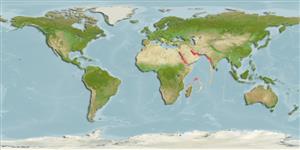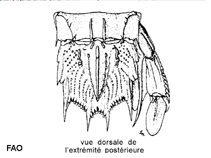Erugosquilla massavensis (Kossmann, 1880)
Red Sea mantis shrimp| Native range | All suitable habitat | Point map | Year 2050 |

|
| This map was computer-generated and has not yet been reviewed. |
| Erugosquilla massavensis AquaMaps Data sources: GBIF OBIS |
Classification / Names Common names | Synonyms | CoL | ITIS | WoRMS
Malacostraca | Stomatopoda | Squillidae
Environment: milieu / climate zone / depth range / distribution range Ecology
Benthic; depth range 9 - 200 m (Ref. 128606), usually 20 - 40 m (Ref. 3497). Subtropical; 30°N - 7°N, 32°E - 88°E
Distribution Countries | FAO areas | Ecosystems | Occurrences | Introductions
Indian Ocean: from Red Sea north to Orissa India. Introduced in the Mediterranean.
Length at first maturity / Size / Weight / Age
Maturity: Lm ? range ? - ? cm Max length : 21.6 cm TL male/unsexed; (Ref. 365); common length : 15.0 cm TL male/unsexed; (Ref. 365)
Short description Morphology
Length: common up to 15 cm (Ref. 363).
Even if it currently does not have a commercial importance in the Mediterranean (rare on the markets of Cyprus, Israel and Turkey), this species can have a potential importance for fishing. Common on the markets of Suez and lsmaïlia. Maximum depth from Ref. 122160. Prefers soft bottoms in coastal waters but also tolerates open waters and sheltered brackish areas (Ref. 122163). Above muddy, sandy, argillaceous funds and of gravel at depths of 10 to 50 m (Ref. 365). Also over sandy-silt bottoms at depths between 150 and 200 m (Ref. 122160).
Life cycle and mating behavior Maturity | Reproduction | Spawning | Eggs | Fecundity | Larvae
Some members of the order Stomatopoda pair for life and some come together only to mate. Males produce sperm ducts rather than spermatophores; females can brood a maximum of 50,000 eggs. Life cycle: Eggs hatch to a planktonic zoea which lasts for 3 months.
Main reference
References | Coordinator | Collaborators
Manning, R.B. 1995. (Ref. 3145)
IUCN Red List Status (Ref. 130435)
CITES status (Ref. 108899)
Not Evaluated
CMS (Ref. 116361)
Not Evaluated
Threat to humans
Harmless
Human uses
Fisheries: commercial
| FishSource |
Tools
More information
Internet sources
BHL | BOLD Systems | CISTI | DiscoverLife | FAO(Publication : search) | Fishipedia | GenBank (genome, nucleotide) | GloBI | Gomexsi | Google Books | Google Scholar | Google | PubMed | Tree of Life | Wikipedia (Go, Search) | Zoological Record



